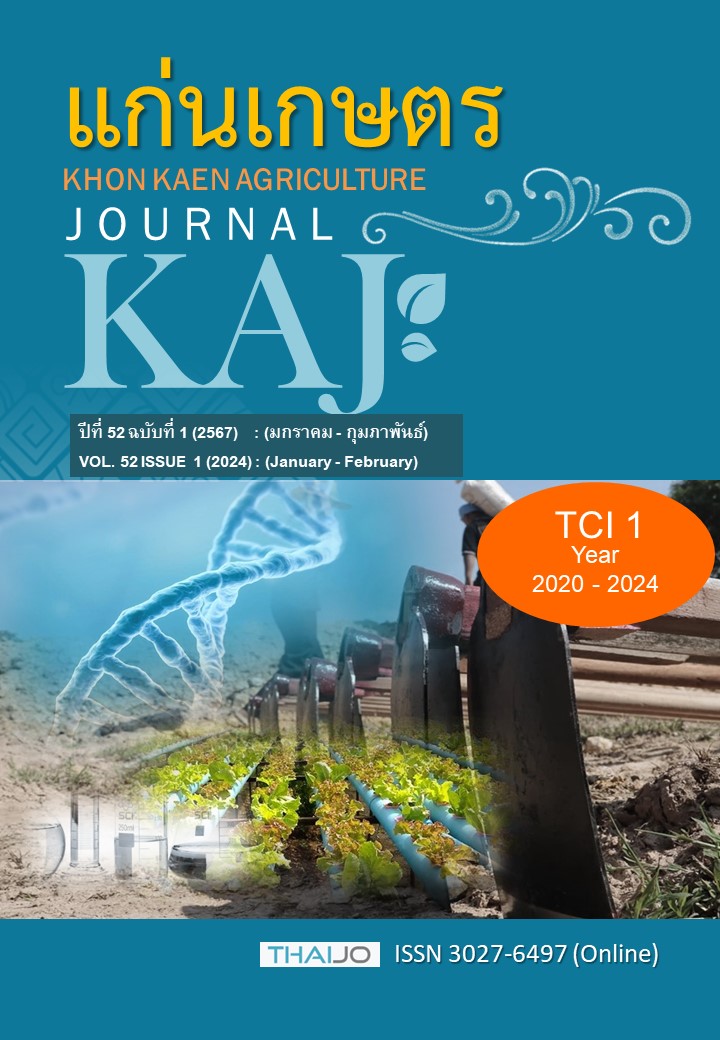กระบวนการต้นแบบการผลิตอาหารสำเร็จรูปสำหรับการเลี้ยงปูทะเล
Main Article Content
บทคัดย่อ
เนื่องจากอาหารสำเร็จรูปสำหรับเลี้ยงปูทะเลมีอยู่อย่างจำกัดในตลาด กระบวนการผลิตขนาดเล็กที่เรียบง่ายและปรับเปลี่ยนได้ จึงเป็นทางออกที่ดีสำหรับการพัฒนาอุตสาหกรรมการเพาะเลี้ยงปู ในที่นี้ เราได้อธิบายต้นแบบสำหรับการผลิตอาหารสำเร็จรูปซึ่งประกอบด้วยอาหารกุ้งป่น (42.5%) สารยึดเกาะ ได้แก่ วีทกลูเตน (7.5%) และอัลฟ่าสตาร์ช (2.5%) เนื้อปลาบด (5%) และผงเคล (2.5%) นำมาขึ้นรูปเป็นอาหารเม็ดในรูปแบบแท่ง โดยใช้เครื่องอัดแท่งอาหารขนาดเล็กที่หาซื้อได้ง่ายและราคาไม่แพง อบที่ 60 องศาเซลเซียส เป็นเวลา 2 ชั่วโมง อาหารสำเร็จรูปที่ผลิตได้สามารถเก็บได้ในอุณหภูมิห้องเป็นเวลา 1 สัปดาห์ เมื่อทำการศึกษา การคงตัวในน้ำ คุณค่าทางโภชนาการและการทดสอบการกิน เปรียบเทียบกับอาหารที่มีขายในท้องตลาด พบว่าคุณค่าทางโภชนาการหลัก ได้แก่ โปรตีน ไขมัน และคาร์โบไฮเดรตของอาหารต้นแบบมีค่าเท่ากับ 40.08±0.14%, 5.3±0.04%, 27.14% ตามลำดับ ในขณะที่คุณค่าทางโภชนาการอาหารที่มีขายในท้องตลาด อยู่ที่ 39.63±0.08%, 12.19±0.24% และ 27.37% ตามลำดับ ความสามารถคงตัวในน้ำระหว่างอาหารสำเร็จรูปทั้งสอง พบว่ามีความแตกต่างกันอย่างมีนัยสำคัญหลังจาก 2 ชั่วโมง (89.35±1.54% ในอาหารต้นแบบและ 80.49±2.74% ในอาหารเชิงพาณิชย์) และ 3 ชั่วโมง (78.17±0.41% ในอาหารต้นแบบและ 73.06±2.22% ในอาหารเชิงพาณิชย์) ในขณะที่ชั่วโมงแรกมีค่าที่ใกล้เคียงกัน นอกจากนี้อาหารต้นแบบสามารถดึงดูดการกินของปูได้ดีกว่าเม็ดเชิงพาณิชย์ (86.67% และ 60.00% (n=15) ตามลำดับ) ในขณะที่ค่าการกิน (palatability) อยู่ที่ 64.10% สูงกว่าอาหารท้องตลาด (10.83%) อย่างมีนัยสำคัญ (P<0.05) เมื่อพิจารณาต้นทุนการผลิตแล้ว การผลิตต้นแบบแต่ละรอบจะมีราคาประมาณ 3 สตางค์/เม็ด (น้ำหนักประมาณ 0.4 กรัม/เม็ด) และต้องใช้สามเม็ดในการให้อาหารในปริมาณที่ใกล้เคียงกับอาหารท้องตลาด ดังนั้นการให้อาหารในแต่ละมื้อ อาหารต้นแบบจะมีราคาต่ำกว่าอาหารเชิงพาณิชย์ (8 และ 12 สตางค์ ตามลำดับ) จากการศึกษาครั้งนี้ อาหารต้นแบบมีความเรียบง่ายและยืดหยุ่นสำหรับการผลิตขนาดเล็กและช่วยให้เกษตรกรผู้เลี้ยงปูทะเลสามารถออกแบบสูตรอาหารของตนเองได้
Article Details

อนุญาตภายใต้เงื่อนไข Creative Commons Attribution-NonCommercial-NoDerivatives 4.0 International License.
เอกสารอ้างอิง
กรมประมง. 2563. สถิติฟาร์มเลี้ยงปูทะเล ประจำปี 2562 กลุ่มสถิติการประมง กองนโยบายและแผนพัฒนาการประมง เอกสารฉบับที่ 15/2563.
พิศมัย สมสืบ. 2564. ขนาดอาหาร ค่าความคงทน และการปนเปื้อนสารพิษจากเชื้อราในอาหารกุ้งทะเล feed size, water stability of shrimp feed and analysis on Mycotoxin contamination. กองวิจัยและพัฒนาอาหารสัตว์น้ำ กรมประมง กระทรวงเกษตรและสหกรณ์.
Aaqillah-Amr, M.A., A. Hidir, M.N. Azra, A.R. Ahmad-Ideris, M.H. Abualreesh, M.N. Noordiyana, and M. Ikhwanuddin. 2021. Use of pelleted diets in commercially farmed decapods during Juvenile stages. A review. Animals (Basel). 11(6): 1761.
Alava, V.R., E.T. Quinitio, J.B. de-Pedro, F.M.P. Priolo, Z.G.A. Orosco, and M. Wille. 2007. Reproductive performance, lipids and fatty acids of mud crab Scylla serrata (Forsskal) fed dietary lipid levels. Aquaculture Research. 38: 1442–1451.
Ali, S.A., J.S. Dayal, and K. Ambasankar. 2011. Presentation and evaluation of formulated feed for mud crab Scylla serrata. Indian Journal of Fisheries. 58(2): 67-73.
Azra, M.N., and M. Ikhwanuddin. 2016. A review of maturation diets for mud crab genus Scylla broodstock: Present research, problems and future perspective. Saudi Journal of Biological Sciences. 23: 257-267.
Catacutan, M. 2002. Growth and body composition of juvenile mud crab, Scylla serrata, fed different dietary protein and lipid levels and protein to energy ratios. Aquaculture. 208: 113–123.
Chung, M.-Y., C.-H. Liu, Y.N. Chen, and W. Cheng. 2011. Enhancing the reproductive performance of tiger shrimp, Penaeus monodon, by incorporating sodium alginate in the broodstock and larval diets. Aquaculture. 312: 180–184.
Djunaidah, L.S., M. Wille, E.K. Kontara, and P. Sorgeloos. 2003. Reproductive performance and offspring quality in mud crab (Scylla paramamosain) broodstock fed different diets. Aquaculture International. 11: 3–15.
Elsayed, F. 2016. "Behavioral Studies of Chemoreception by the Pacific White Shrimp Litopenaeus Vannamei: Testing Attractability and Palatability of Proprietary Chemical Mixtures that Augment Feed Pellets Used in Shrimp Aquaculture." Thesis, Georgia State University. doi: 10.57709/8547637.
Genodepa, J., C. Zeng, and P.C. Southgate. 2004. Preliminary assessment of a microbound diet as an Artemia replacement for mud crab, Scylla serrata, megalopa. Aquaculture. 236: 497-509.
Hasnidar, H., A. Tamsil, and M.I. Wamnebo. 2021. The effects of the amaranth extract (Amaranthus spp.) on the molting of orange mud crab (Scylla olivacea). AACL Bioflux. 14(2): 1035-1045.
Haesman, M.P., D.R. Fielder, and R.K. Shepherd. 1985. Mating and spawning in the mud crab, Scylla serrata (Forskal) (Decapoda, Portunidae). Australian Journal of Marine and Freshwater Research. 36: 773–783.
Holme, M.H., P.C. Southgate, and C. Zeng. 2007. Assessment of dietary lecithin and cholesterol requirements of mud crab, Scylla serrata, megalopa using semi-purified microbound diets. Aquaculture Nutrition. 13: 413-423.
Koolkalya, S., T. Thapanand, S. Tunkijjanujij, V. Havanont, and T. Jutagate. 2006. Aspects in spawning biology and migration of the mud crab Scylla olivacea in the Andaman Sea, Thailand. Fisheries Management and Ecology. 13(6): 391–397.
Lavens, P., E. Lebegue, H. Jaunet, A. Brunel, P.H. Dhert, and P. Sorgeloos. 1999. Effect of dietary essential fatty acids and vitamins on egg quality in turbot broodstocks. Aquaculture International. 7: 225-240.
Millamena, O.M., and E. Quinitio. 2000. The effects of diets on reproductive performance of eyestalk ablated and intact mud crab Scylla serrata. Aquaculture. 181: 81–92.
Pattiasina, B.J., E. Jamal, and A.Y. Pattinasarany. 2012. The effect of different feed on the spawning performance of mud crab Scylla serrata broodstock. Journal of Akuakultur Indonesia. 11: 153–161.
Robertson, W.D., and A. Kruger. 1994. Size at maturity, mating and spawning in the portunid crab Scylla serrata (Forskål) in Natal. South Africa Estuarine Coastal and Shelf Science. 39: 185–200.
Sheen, S.S., and S.W. Wu. 1999. The effects of dietary lipid levels on the growth response of juvenile mud crab Scylla serrata. Aquaculture. 175: 143-153.
Suprayudi, M.A., T. Takeuchi, and K. Hamasaki. 2002. The effect of n-3 HUFA content in rotifers on the development and survival of mud crab, Scylla serrata, larvae. Suisanzoshoku. 50(2): 205–212.
Suprayudi, M.A., T. Takeuchi, and K. Hamasaki. 2004. Effect Artemia enriched with EPA and DHA on the survival and the occurrence of molting failure to megalop of mud crab, Scylla serrata larvae. Fisheries Science. 70: 650-658.
Suprayudi, M.A., T. Takeuchi, and K. Hamasaki. 2012. Phospholipids effect on Survival and Molting Synchronicity of Larvae Mud Crab Scylla serrata. HAYATI Journal of Biosciences. 19(4): 163-168.
Tamsil, A., and H. Hasnidar. 2017. The Effect of molting hormone (20-hydroxyecdysone) on molting of mud crab (Scylla olivacea Herbst, 1976). Ecology Environment and Conservation. 24: 960-967.
Unnikrishnan, U., and R. Paulraj. 2010. Dietary protein requirement of giant mud crab Scylla serrata juveniles fed iso-energetic formulated diets having graded protein levels. Aquaculture Research. 41: 278–294.
Zhao, J., X. Wen, S. Li, D. Zhu, and Y. Li. 2016. Effects of different dietary lipid sources on tissue fatty acid composition, serum biochemical parameters and fatty acid synthase of juvenile mud crab Scylla paramamosain (Estampador 1949). Aquaculture Research. 47: 887–899.


